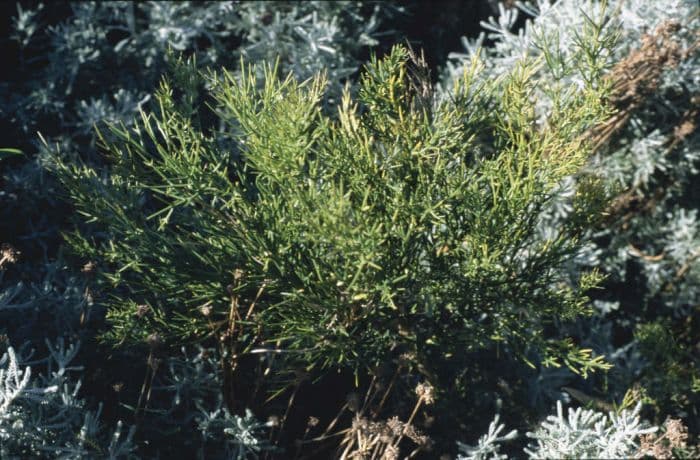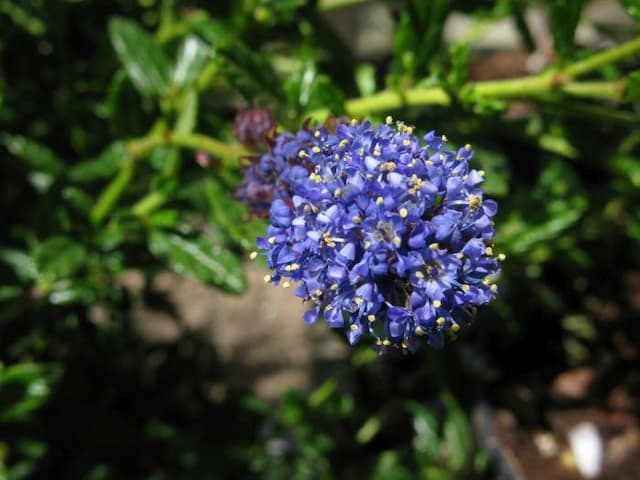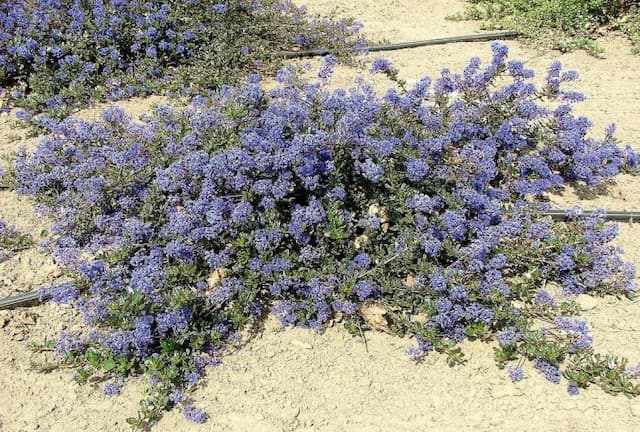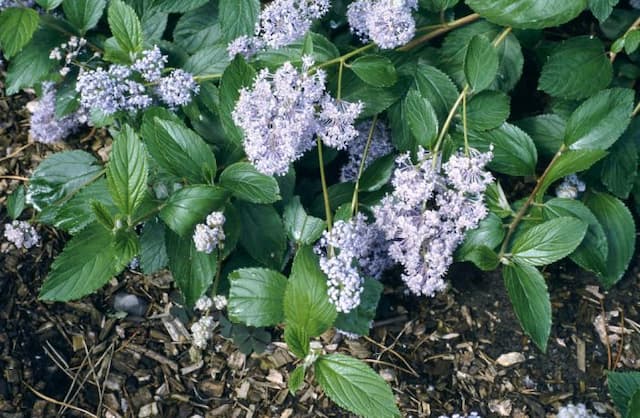Anchor Plant Colletia hystrix

ABOUT
The plant known commonly as the Anchor Plant is a unique and visually striking shrub. Its most notable feature is its stems, which are flattened and modified to serve as leaves, a phenomenon commonly known as phyllodes. These phyllode structures are sharply pointed and arranged in an alternate pattern along the branches, giving the plant a thorny, almost aggressive appearance. The edges of these leaf-like stems are wavy or sinuous, adding to the plant's distinctive texture. The Anchor Plant is typically gray-green, providing it with a somewhat subdued color that can blend into rocky or dry landscapes where it is often found. During its blooming season, the plant produces small, inconspicuous white or pale pink flowers that are shaped like tiny stars or pompoms. These flowers are usually clustered at the nodes where the phyllodes meet the stem. The blooms emit a strong, sweet fragrance, which can be quite noticeable and is often a sharp contrast to the plant's tough appearance. Following the flowering phase, the plant may produce small fruit that are dry and hard, resembling little capsules. These fruits generally contain seeds, which can be used for propagation. The overall structure of the Anchor Plant is dense and interwoven, making it not only a visually interesting specimen in gardens or natural settings but also providing a habitat for various forms of wildlife. Its formidable appearance makes it an excellent choice for those seeking a low-maintenance but intriguing addition to their collection of ornamental plants.
About this plant
 Names
NamesFamily
Rhamnaceae
Synonyms
Anchor Plant, Crucifixion Thorn
Common names
Colletia cruciata, Colletium hystrix.
 Toxicity
ToxicityTo humans
Colletia hystrix, commonly known as the Anchor Plant, contains saponins, which are toxic to humans if ingested. Although saponins are poorly absorbed by the human body, ingestion of significant amounts of the plant can cause vomiting, diarrhea, and nausea. Ingesting parts of the Anchor Plant can also lead to more severe symptoms such as stomach cramps and more serious gastrointestinal issues. Contact with skin or eyes should also be avoided as it can cause irritation.
To pets
The Anchor Plant is also toxic to pets due to the presence of saponins. If pets ingest parts of Colletia hystrix, they may exhibit symptoms such as vomiting, diarrhea, and abdominal pain. In severe cases, ingestion of the plant can result in more serious health issues such as weakness, lethargy, and changes in urine color due to potential damage to red blood cells. It is important to prevent pets from ingesting any part of the plant to avoid these adverse effects.
 Characteristics
CharacteristicsLife cycle
Perennials
Foliage type
Evergreen
Color of leaves
Green
Flower color
White
Height
8 feet (2.4 meters)
Spread
6 feet (1.8 meters)
Plant type
Shrub
Hardiness zones
8
Native area
South America
Benefits
 General Benefits
General Benefits- Landscape interest: Colletia hystrix, commonly known as the Crucifixion Thorn, has a distinctive appearance with sharp, thorn-like stems and a unique, sculptural form that can add visual interest to a garden or landscape design.
- Drought tolerance: The Crucifixion Thorn is well adapted to arid conditions and can survive on minimal water, making it an excellent choice for xeriscaping or drought-prone regions.
- Low maintenance: This plant requires little care once established, enduring poor soil and neglect, which is ideal for gardeners looking for low-maintenance plants.
- Wildlife habitat: The dense structure and thorns provide shelter and protection for birds and other small wildlife, creating a safe haven for them within the landscape.
- Erosion control: With its extensive root system, Colletia hystrix can be used to stabilize slopes and prevent soil erosion in areas vulnerable to this issue.
- Architectural plant: Its striking form makes it a good choice for use as an architectural plant, providing a focal point or enhancing the geometric design within a landscaping project.
 Medical Properties
Medical PropertiesThis plant is not used for medical purposes.
 Air-purifying Qualities
Air-purifying QualitiesThis plant is not specifically known for air purifying qualities.
 Other Uses
Other Uses- Crucifixion Thorn can be used as a natural barrier or security hedge due to its sharp thorns and dense growth, making it difficult for intruders to pass through.
- The plant's unique appearance, featuring spiky stems, can lend an exotic aesthetic to rock gardens and create a focal point of architectural interest.
- Crucifixion Thorn's stems are sometimes used in the creation of art pieces or in floral arrangements where a stark, dramatic look is desired.
- The plant can serve educational purposes in botanical gardens, offering a representative example of xerophytic plants adapted to arid environments.
- Its resilient nature allows Crucifixion Thorn to be utilized in erosion control projects where other plants may not thrive.
- The plant might be employed in themed garden designs that simulate prehistoric or extraterrestrial landscapes due to its unusual form.
- Enthusiasts of unusual plants might collect and cultivate Crucifixion Thorn, contributing to the biodiversity of private or community plant collections.
- Its ability to survive with minimal water makes it a prime candidate for xeriscaping, a landscaping style that reduces the need for irrigation.
- Crucifixion Thorn can act as a windbreak in areas that experience strong winds and where other plants may be damaged.
- In regions where it is native, it may play a role in traditional ceremonies or cultural practices that involve the use of local plants.
Interesting Facts
 Feng Shui
Feng ShuiThe Crucifixion Thorn is not used in Feng Shui practice.
 Zodiac Sign Compitability
Zodiac Sign CompitabilityThe Crucifixion Thorn is not used in astrology practice.
 Plant Symbolism
Plant Symbolism- Resilience: Colletia hystrix, also known as the Crucifixion thorn, has a tough, spiny structure that helps it survive in harsh conditions, making it a symbol of resilience and the ability to endure challenges.
- Protection: With its sharp thorns, the Crucifixion thorn can serve as a natural barrier, symbolizing protection and defense against harm.
- Spiritual suffering: The common name 'Crucifixion thorn' suggests a connection to the suffering of Christ on the cross, and thus it can represent sacrifice, faith, and redemption through hardship.
- Adaptation: Adapted to arid environments, Crucifixion thorn symbolizes the ability to adjust and thrive in diverse and difficult conditions.
- Beauty in austerity: Despite its seemingly unfriendly thorny appearance, the Crucifixion thorn produces flowers, symbolizing the unexpected beauty and grace that can be found in austere environments or situations.
 Water
WaterThe plant commonly known as Crucifixion Thorn should be watered when the top inch of soil has dried out. This could mean watering every week or two, depending on the climate and season. It's best to provide a deep watering, which might involve using around 1 to 2 gallons of water for outdoor plants or more for more significant landscape specimens, depending on their size and the weather conditions. Ensure the water penetrates deeply into the soil to encourage robust root development. It is crucial not to overwater the Crucifixion Thorn, as it is drought-tolerant and too much moisture can lead to root rot.
 Light
LightCrucifixion Thorn thrives in full sun to partial shade. Therefore, the optimal spot for this plant would be somewhere it can receive six or more hours of direct sunlight on most days. A south-facing or west-facing location is often suitable for satisfying its light requirements.
 Temperature
TemperatureCrucifixion Thorn is quite hardy and can withstand a broad range of temperatures, typically from about 25°F to 100°F. This range allows it to survive occasional frost and high heat. Optimal growing temperatures are usually between 60°F and 85°F, which promotes healthy growth and flowering.
 Pruning
PruningPrune Crucifixion Thorn to maintain shape, remove any damaged or diseased branches, and to encourage new growth. Pruning is best done in late winter or early spring before new growth begins. It's not a plant that requires frequent pruning, so once a year or even less often may be sufficient, depending on the desired shape and size.
 Cleaning
CleaningAs needed
 Soil
SoilThe Crucifixion Thorn thrives in well-draining, loamy or sandy soil that is moderately fertile. A good mix could be one part sand, one part garden soil, and one part peat or compost to ensure good drainage and aeration. The ideal soil pH should be slightly acidic to neutral, ranging from 5.5 to 7.5. Adjust pH accordingly if testing indicates it is outside this range.
 Repotting
RepottingCrucifixion Thorns should be repotted every two to three years, or when it has outgrown its current pot. Carefully handle its sharp spines during repotting and choose a slightly larger pot each time to give the roots ample space to grow.
 Humidity & Misting
Humidity & MistingCrucifixion Thorns prefer low to moderate humidity levels, as they are accustomed to drier environments. Humidity levels around 40-50% are suitable for this plant, and it is quite tolerant of the lower humidity levels commonly found in home environments.
 Suitable locations
Suitable locationsIndoor
Grow Crucifixion Thorn in bright light with well-draining soil.
Outdoor
Plant Crucifixion Thorn in sunny spot with well-draining soil.
Hardiness zone
7-10 USDA
 Life cycle
Life cycleThe life cycle of Colletia hystrix, commonly known as Thorn of the Cross, begins with seed germination, which occurs in well-draining soil under suitable temperature and moisture conditions. Once the seed germinates, a seedling emerges and establishes itself, developing a taproot and foliage. As the seedling matures into a young plant, it develops its characteristic sharp, thorn-like modified stems and small leaves, adapting to arid environments. Flowering occurs in mature plants, producing small, fragrant white flowers that are pollinated by insects, primarily bees. Following pollination, the plant produces dry, one-seeded fruits that eventually disperse, completing the reproductive cycle. Throughout its life, which can span several years, Thorn of the Cross experiences periods of growth and dormancy, adapting to seasonal changes in its native environment.
 Propogation
PropogationPropogation time
Spring-Fall
Colletia hystrix, commonly known as the Anchor Plant, is often propagated through semi-hardwood cuttings. This method is generally undertaken during the summer months when the plant is actively growing. You would take a cutting approximately 4 to 6 inches (10 to 15 cm) in length, making sure it has several nodes. The lower end of the cutting is dipped in rooting hormone to enhance the development of roots and then placed in a well-draining potting mix. The pot should be kept in a warm, semi-shaded area and maintained moist until the cutting has rooted well, which can take a few weeks. During this period, it's vital to ensure the cutting does not dry out but also to avoid overwatering, which can lead to rot.









